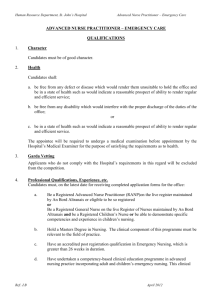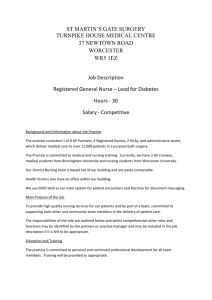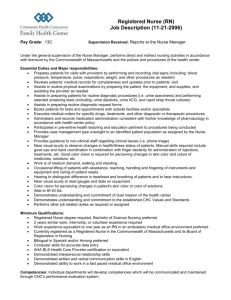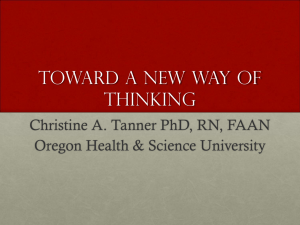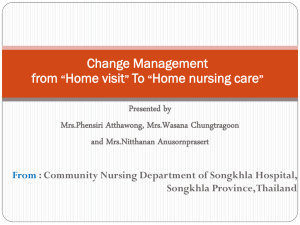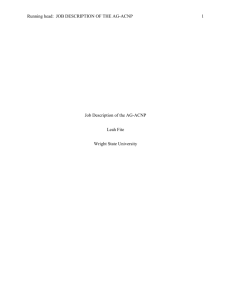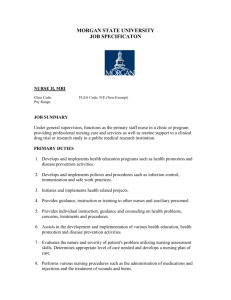Nursing Leadership & Management Concepts Presentation
advertisement
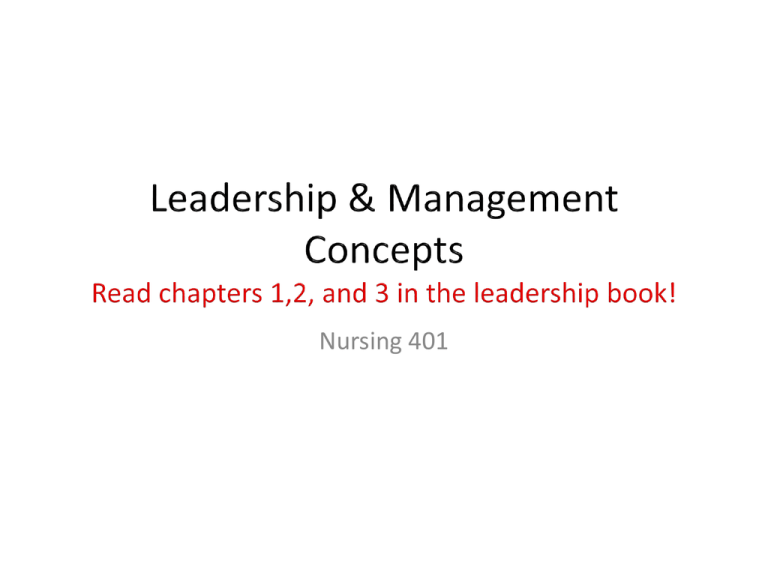
Nursing 401 “Courage is not the absence of fear, it’s inspiring others to move beyond it” - Nelson Mandela • Critical thinking – thinking about lots of things at any given time, multitasking. The ability to be able to take all that information in, reorganize it, and spit it back out in an organized fashion • Vision • Influence – Not all influence is good, you can influence people in a bad way. It’s your choice to be good or bad • Empower – To give people the tools they need to do what they need to be able to do • • • • Communication Collaborative Genuine Healthy work environment – Huge push right now in nursing… – Read the article he posted, what it means to be a leader and what a healthy work environment entails • • • • • Trait Theories Behavioral Theory Situational Interactional Transactional/Transformational • • • • Autocratic Democratic Laissez-faire Bureaucratic • • • • • Charismatic Transactional Transformational Connective Shared • Leader makes decisions for the group • Assumes workers are incapable of independent decisions • Where is this style effective? – Military does this perfectly – When the leader is the expert, what they say goes – Effective in code situations and what not • Leader encourages participative decisionmaking • Empowers workers through collaboration • Communication flow up and down • • • • • • Presumes workers are internally motivated Hands off approach Assumes autonomy Not a good style for every situation You have to know the style of person Veterans – will do what the dr tells them to, but maybe not you. Don’t change very well… Told stories of his dad • Baby boomers – hard workers, come in early, stays late. Invented casual Friday, i.e. work hard and play hard. • Generation X – Pearl Jam and what not. They like to get a task, leave them alone, don’t tell them how to do it. “Latchkey Kids.” Like to have a task and be left alone, don’t tell them how to do it. Don’t like to be micro managed. • Millennial Generation – have reputation of being hard workers, good task people. Get things done when given a task. • • • • Assumes workers are externally motivated Relies on organizational rules and policies. Inflexible approach Everything is done is a specific way… They discount completely the humanistic factor, but the policy is the policy is the policy. There is a problem with this, you have to sometimes amend that. • Personality invokes commitment • Emotional relationship is formed with group members • Establishes rapport through contact • Network very well • Focused on day-to-day tasks to achieve organizational goals • Incentives to promote loyalty • Emphasizes the process • Attempts to control situations and followers • The control factor is an issue, this might be the person that is a micromanager… • • • • Fosters creativity, risk-taking, collaboration Empowers workers Promotes independence, growth, change Converts followers to leader through shared values, trust and honesty • But still focuses on the operational aspects of your day to day leadership • Promotes collaboration and teamwork • Assumes the organization contains many leaders • Members get equal share in decision-making • Participated decision making (shared decision making) is like how everyone gets a voice in the situation. The problems with this is that if you have large groups, you can’t always have everyone’s voice counting all the time • • • • • Introduction of managed care Greater emphasis on business New challenges Expanded roles Changed the face of nursing, made it more like a business model, not just a medical model or whatever. • The most expensive commodity in the hospital is nurses. Any healthcare organization, we are their biggest expense • • • • • Servant Authentic Thought Quantum Cultural Bridging “ to be a great leader, one must be a servant first.” -Florence Nightingale • • • • Communicator Open minded Critical thinker Self-directed Being a leader isn’t about telling people what to do and expecting them to do it. Need to be a servant first. Think about humility • Exhibits humility – Being able to admit when you were wrong • Emotional intelligence – Self awareness • Connects relationships • Emotional intelligence refers to the ability to use emotions effectively and is required by leader/managers in order to enhance their success. • Emotional intelligence is critical for building a cooperative and effective team. • You have to listen to what’s going on • • • • • Self-awareness Self-regulation Motivation Empathy Social skills – Networking with others, resource utilization is important • Adopted by the Nursing Organization Alliance • This is the #1 nursing style of leadership right now, it would be beneficial to read about this and be familiar with it… • “the glue that holds together a healthy work environment.” (Shirey, p. 257, 2006) • Authentic leadership suggests that in order to lead, leaders must be true to themselves and their values and act accordingly. • Values and purpose are linked! What is the definition of transparent integrity? a. Holding one’s employees accountable b. Standing by one’s values in the face of pressure c. Willingly following the rules of one’s organization d. All of the above • Purpose – Key component. Maybe hear congruent leader, meaning that you are able to walk the walk. When you say something you’re going to do it. When you talk about stuff you’re genuine and follow thru. Lead by example. What you say and what you do are the same • • • • Exhibit self-discipline Link purpose and values Establish relationships Lead with your heart and ears – You listen and you use your values in decision making • Create healthy work environment • A work setting structured in such a way, employees can achieve personal satisfaction. (Shirey, 2006) • If you’re in a leadership role, what’s important for your employees. You need to listen, ask them, what is important to you? Gen X people want to work, then get outta here! Go home and do stuff that they want to do! Baby boomers want to work long hours in the hope that they will be running the show someday. • Employees are treated respectfully • Strong trust between management and staff – Way to do this is keeping your word, congruent leadership, walk the walk, listen! • Pervasive communication and collaboration • Employees feel safe – Physical safety and emotional safety – There have to be emotional outlets for people – Physical safety could be making sure everyone on your floor understand proper body mechanics so they don’t get hurt lifting people… • • • • • • • Humility Courage Empathy Fair-mindedness Integrity Perseverance Faith in Reason – You have to have faith in the process and your people, very very important • Confidence • Contextual Perspective – If they’re always late, don’t just make a snap decision, ask why they’re late, maybe having family problems or something • Creativity • Flexibility • Inquisitiveness • Integrity • Intuition • Open-mindedness • • • • Thought provoking style Attract others through innovation Choose ideas with significant impact Provoking innovation in others, empowerment • • • • • Based on environmental conditions Change is constant Constant interaction with the environment Connecting points in time Environment is always changing! Veterans and people who don’t like change will have problems with this! Thought leaders attract followers by the promise of representation or empowerment. A. True B. False Which of the Following Is a Component of Emotional Intelligence? • Self-reliance • Assertiveness • Self-regulation • Charisma Industrial leadership style Focused on tasks and getting the job done to increase productivity. Missing humanistic factor, things happen, etc. VS. Relationship Age Leadership Decision Making, Problem Solving, and Thinking Critically • • • • Result or outcome-oriented Good problem-solving skills Effective team-builder Encourage “followership” – Followership means setting a good example so people want to emulate you • Facilitates task management • Scientific management (1900-1930) - Frederick Taylor More the industrial age, if you teach people to do this like a robot, productivity will go up o Management Functions - Henri Fayol (1925) hawthorn something or other, in the book o Human Relations Management o Everything from this point forward has included the human aspect Upper Organizational responsibilities Middle Liaison to upper management First day-to-day operations • • • • • • Leadership Planning Organizing Coordinating Directing Thinking critically Planning Organizing Controlling Staffing Directing • Competing values in management, you’re always moving between all of these characteristics • Conflict management – HUGE! Always a lot of this! • Assertiveness • Advocacy – The pt and your staff, and your collegues • Supervision • Decision Making • • • • Cognitive process Choosing a course of action Entails comprehensive problem solving skills Critical thinking – More complex than decision making • Experiential Learning – Learning by doing, not just by being told • Sometimes not making a decision is making a decision… • Hands on approach • Mock experiences • Focused interaction between learners and management • Assess • Identify the decision • Plan • Identify criteria for decision • Choose and alternative • Evaluate steps in decision • Implement • Evaluation • • • • • Define Objectives Gather data accurately Generate alternatives Think logically Act decisively You can make a decision and never solve the underlying problem, but you should. Don’t just make a decision based on what needs to happen • Take time to reflect • Establish goals and objectives • Define the purpose of the decision • • • • Accuracy is crucial Identify the problem Persistent Perception may influence values • Decisions made on the best evidence • Understanding why certain practices are appropriate • Understanding how best practices evolved • Generate many alternatives • May choose to not do anything • Brainstorming • Deductive reasoning • Think through the information • Questions related to problem • Think of your own values • Over-generalizing • Affirming the Consequences • Arguing from the analogy • • • • Consequences to actions Change must be evaluated Participative decision making Ongoing learning process • Make a decision!! Right, wrong, or indifferent… Just do the shit already • Dynamic in nature • Vary from person-to-person • Gender – Women use more neuro capacities, different hemospheres, blah blah blah • Values • Life experience – Really influence how you make decisions, comes into play about being self aware… • Individual preference • • • • Self-awareness Life experiences Individual preference Individual thought process • Organizational dynamics • The influence of power • The use of decision-making tools - decision grids - payoff tables - decision trees - consequence tables • Think long term – Overall vision and direction of things • • • • • Broad-based worldview Influence and motivate others Emphasize vision and values Embrace change Capable of coping with conflict • • • • Functions as a role model Life-long learner Utilizes evidence-based practice Team building Performance Outer Results Skills Abilities Technical Leader Competence Character Adaptive Influence Inner Authenticity • You are working as a nurse in the adult ED. The flight crew arrives in the adult ED proclaiming an airway emergency following a MVC. No trauma activation has occurred. • How would you expect the nurse manager handle the situation? • You are the nurse manager on a cardiac telemetry floor. An experienced nurse that is 6 months off orientation fails to level chest tubes, document output, and complete I’s and O’s. When confronted, the nurse states, “it is not my fault. You did not give me what I needed in orientation.” • A long time nurse working on the unit is outspoken and negative in the workplace about everything. The employee is known to be a hard worker and often works overtime, helping out when needed. However, his/her behavior is toxic to the overall work environment. • How would you handle this situation as a nurse/nurse manager? Marquis, B. L., & Huston C. J. (2006). Leadership roles and management functions in nursing: Theory and application. Philadelphia: Wolters Kluwer. Shirey, M. R. (2006). Authentic leaders creating healthy work environments for nursing practice. American Journal of Critical Care, 15(3), 256-267.




